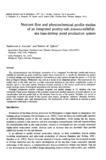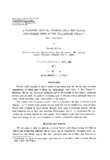Alkalinity control in ozonated shrimp pond water
| dc.contributor.author | Whangchai, N. | |
| dc.contributor.author | Migo, Veronica P. | |
| dc.contributor.author | Young, H. K. | |
| dc.contributor.author | Matsumura, M. | |
| dc.contributor.editor | Lavilla-Pitogo, Celia R. | |
| dc.contributor.editor | Cruz-Lacierda, Erlinda R. | |
| dc.date.accessioned | 2021-10-21T02:59:18Z | |
| dc.date.available | 2021-10-21T02:59:18Z | |
| dc.date.issued | 2002 | |
| dc.identifier.citation | Whangchai, N., Migo, V. P., Young, H. K., & Matsumura, M. (2002). Alkalinity control in ozonated shrimp pond water. In C. R. Lavilla-Pitogo & E. R. Cruz-Lacierda (Eds.), Diseases in Asian aquaculture IV: Proceedings of the Fourth Symposium on Diseases in Asian Aquaculture, 22-26 November 1999, Cebu City, Philippines (pp. 113-124). Fish Health Section, Asian Fisheries Society. | en |
| dc.identifier.isbn | 9718020160 | |
| dc.identifier.uri | http://hdl.handle.net/10862/6202 | |
| dc.description.abstract | The use of ozone for aquaculture has been shown to be effective, not only for disinfection of pathogenic bacteria and viruses, but also for removal of toxic ammonia, nitrite and hydrogen sulfide. However, ozonation of shrimp pond water has a tendency to decrease alkalinity, thereby causing extreme pH fluctuations and affecting the buffering capacity of the pond water. Since the maintenance of alkalinity at optimum levels is very important for shrimp culture, basic research to find suitable strategies to maintain a desired level of alkalinity studies were conducted by ozonating artificial seawater containing ammonia. In the ozonation experiments, pH, alkalinity and total ammonia were monitored. Alkalinity decreased while ammonia was oxidized by oxidants (hypobromous acid) at the rate of 4.2 ppm alkalinity per 1 ppm NH3-N at pH 8.3. The decreasing trend in pH was also observed during ozonation. Different types of liming materials (agricultural lime, marble dust, and coral sand) were evaluated as alkalinity supplements. However, they were found to be ineffective due to their low solubility. Commercial agricultural lime was found to increase alkalinity by recarbonation using diluted CO2 gas. Other more soluble liming materials, such as sodium bicarbonate (SB) and hydrated lime (HL) were tested as possible alkalinity supplements. Sodium bicarbonate (from Australia and China) A-SB and C-SB, and hydrated lime (commercial and from sugar mill, Philippines) c-HL and s-HL were found to increase alkalinity at the rate of 0.6, 0.6, 0.16 and 0.9 mg/L per 1 ppm liming material, respectively. The pH of the ozonated water with 40 ppm sodium bicarbonate was more stable compared to that with 40 ppm hydrated lime. This implies that with sodium bicarbonate, alkalinity and pH of ozonated pond water can easily be maintained at optimum levels. Hence, the use of ozonation for oxidation, mixing and disinfection, coupled with proper alkalinity control can bring about the maintenance of good water quality for prawn cultivation. | en |
| dc.publisher | Fish Health Section, Asian Fisheries Society | en |
| dc.subject | prawns and shrimps | en |
| dc.title | Alkalinity control in ozonated shrimp pond water | en |
| dc.type | Conference paper | en |
| dc.citation.spage | 113 | en |
| dc.citation.epage | 124 | en |
| dc.citation.conferenceTitle | Diseases in Asian aquaculture IV: Proceedings of the Fourth Symposium on Diseases in Asian Aquaculture, 22-26 November 1999, Cebu City, Philippines | en |
| dc.subject.asfa | alkalinity | en |
| dc.subject.asfa | ozonation | en |
| dc.subject.asfa | shrimp culture | en |
| dc.subject.asfa | liming | en |
| dc.subject.asfa | carbonates | en |
| dc.subject.asfa | pH | en |
Files in this item
| Files | ขนาด | รูป | View |
|---|---|---|---|
|
There are no files associated with this item. |
|||
รายการนี้ปรากฏใน (s)
-
Diseases in Asian aquaculture IV [43]
Proceedings of the Fourth Symposium on Diseases in Asian Aquaculture, 22-26 November 1999, Cebu City, Philippines



